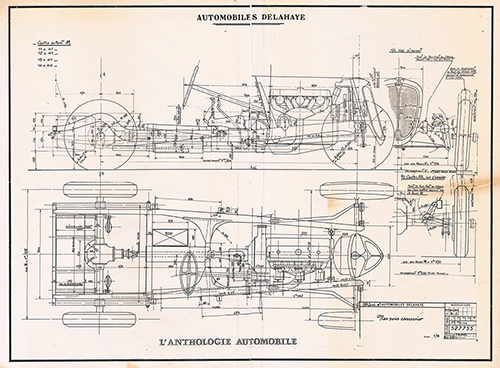The Delahaye years
1935-'36: a new chassis for the luxury market
Author
- André Vaucourt
Date
- December 12, 2012
Related articles
- Delahaye - René Dreyfus and the upset at Pau, by Leif Snellman
- Delahaye 138 - 1933-'35: why Delahaye decided to go racing, by André Vaucourt
- Delahaye 135 - 1936: dominating the 1936 French racing season, by André Vaucourt
- Delahaye 135 - 1936: Delahaye wins nine out of 18 races, by André Vaucourt
- Delahaye 135/145 - 1937: winning big prizes, by André Vaucourt
- Delahaye 135/145/155 - 1938: Delahaye wins the Pau and Cork GPs and comes 1, 2, 4 at Le Mans, by André Vaucourt
- Delahaye 135/145 - 1939: not a very good year for Delahaye, and a terrible year for the world, by André Vaucourt
- Delahaye 135/145/155 - 1945-'46: after five years of war, by André Vaucourt
- Delahaye 135/145/155 - 1947-'48: racing with cars over 12 years old, by André Vaucourt
- Delahaye 145 - What became of the Delahaye 145 V12 chassis no. 48771?, by André Vaucourt
- Delahaye 145 - The history of Delahaye 145 V12 chassis no. 48775, by André Vaucourt
- Delahaye 145 - The brief history of Delahaye 145 V12 chassis no. 48772, by André Vaucourt
- Delahaye 145 - The short history of Delahaye 145 V12 chassis no. 48773, by André Vaucourt
- Delahaye 155 - Delahaye's 155 V12 chassis no. 48774: the worst car they ever built, by André Vaucourt
Who?René Le Begue, Julio Quinlin What?Delahaye 135S Where?Monte Carlo When?1937 Rallye Monte Carlo |
 |
Why?
At the Paris Motor Show in October 1935, the new line of 135 sports cars were on display, and although the 135 Special - the racing car - and the 135 Competition court weren't there, they were in the process of being built and sold to a very selected clientele.
| type | cv/bhp | bore x stroke | displacement | wheelbase | max. speed |
| 135 Sport | 18/95 | 80x107mm | 3227cc | 2.95m | 135kph |
| 135 Coupe des Alpes | 18/113 | 80x107mm | 3227cc | 2.95m | 145kph |
| 135 Competition long | 20/120 | 84x107mm | 3557cc | 2.95m | 155kph |
| 135 Competition court | 20/120 | 84x107mm | 3557cc | 2.70m | 160kph |
| 135 Special | 20/152 | 84x107mm | 3557cc | 2.70m | 185kph |
The new chassis with their respective wheelbases of 2.95m and 2.70m had been built in the final quarter of 1935. The chassis frames were new, fully lowered, and mounted on 17” wheels. The engines were the now fully developed type 103. The 135 Competition court (135Cc) used the same chassis frame as the 135 Special (135S), but with all the mechanical components of the 135 Competition long (135Cl), usually simply referred to as the 135 Competition (135C).
These new, well-proportioned chassis enabled Delahaye to enter the closed-off luxury market. The coach builders were eager to show off their talents, and they did. Many first prizes were won at the numerous Concours d'Elegance, so fashionable in those days.
The 135S was an entirely new car. The 2.70m wheelbase with a front track of 1.38m and rear track of 1.37m wasn't a 2.95m frame cut down by 25cm, like what happened with so many replicas that exist today, but a chassis of lighter construction, with two cross beams at the rear and a central platform, all united by welded gussets. The rails and beams were drilled for lightness. The front suspension was independent by transverse leaf spring, with transverse and oblique arms and Refax transverse friction shock absorbers. The rear suspension was made up of two very flat and long semi-elliptic springs, placed outside the rails, and Refax transverse friction shock absorbers.
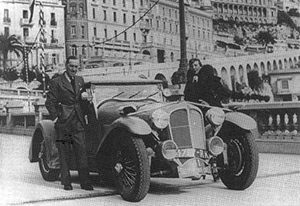
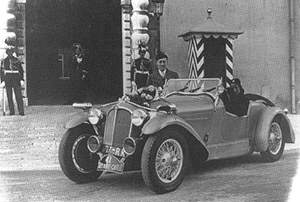
Lucy and Laury Schell celebrating their second place in the 1936 Monte.
The engine was the most potent development of the six-cylinder type 103, the 103J, still with the narrow cast-iron crankcase and head, but with improved water passages through holes drilled in between the cylinder walls. The head had three intake ports and six exhaust ports into one exhaust line. The sturdy crankshaft, drilled from end to end for lubrication, resting on four 65mmm diameter main bearings, had been lightened, as was the flywheel. The high-lift camshaft was placed low in the block while the long pushrods, guided by aluminium alloy supports, actuated the rockers which worked the large-diameter inlet and exhaust valves. The compression ratio was 8.4 to 1. The I-section forged steel cranks were finished by hand and polished while the pistons, with three rings, were made of the RR aluminium alloy. The ignition was by battery coil and distributor or by a Scintilla Vertex magneto .The spark plugs were 14mm. Lubrication was done by a high-pressure gear pump with thermostatically controlled oil cooler while the low-mounted aluminium alloy water pump, fan and radiator looked after the cooling. The 80- or 100-litre fuel tank was placed at the rear, with a mechanical diaphragm fuel pump feeding the three Solex 44HD horizontal carburettors.
The transmission was by a single plate dry clutch with heavy duty mechanism, the magnesium alloy bell housing supporting the engine on the chassis rails. A four-speed and reverse manual gearbox or a Cotal heavy duty electromagnetic semi-automatic gear box with four forward and reverse gears were available. The transmission shaft, with two universal joints, drove the magnesium alloy rear axle with straight cut final drive; 11/12/13x41 and 14x40 gear ratios were made available.
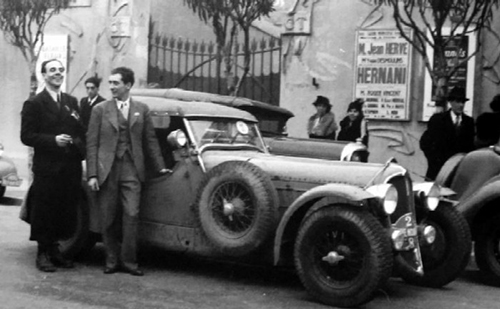
Julio Quinlin and René Le Begue with the 135 Competition Short Chassis after their victory in the 1937 Monte Carlo.
The steering was right-hand drive through screw and nut magnesium alloy steering box. The brakes were cable-operated self-closing “Duo-Servo”, by foot or by hand on all four wheels, with 14” ventilated machined steel or cart-iron drums. The back plates were made of magnesium alloy. The 17”or 18” Rudge wire wheels could be equipped with 5,50x18” or 6,00x 17” tyres. The chassis weighed 850kg, and with the lightweight all-aluminium bodywork, the total weight was around 1000kg.
The coachwork was always made outside since Delahaye had no bodyshop. Most of them were nade by “Lecanu” (Olivier Lecanu Deschamps) but also by Figoni, Chapron and others. The 135 was usually a two-seater but the Le Mans 24 Hours regulations stipulated a four-seater with windscreen, hood and doors. This meant that two tiny seats were fitted in the rear, hardly big enough for children, but very useful for spares and tools, and the windscreen was retractable in front of the firewall.
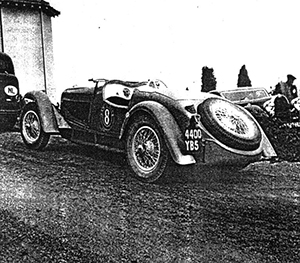

Joseph Paul's 46094 at the Paris-Nice of 1936, with on the right Laury Schell receiving his first prize at the same event.
As one would expect, the first of these 135S was delivered to the Schells in November 1935 and was registered in Paris as 1707RK. Unfortunately, we don't know the chassis number. The delivery came just in time for the Monte Carlo rally in January 1936. This was the Schells' seventh.attempt at this most prestigious event. Starting from Athens, they drove through Bulgaria, Yougoslavia, Hungary, Austria, Germany, and from there on the common leg in France, down the Rhône valley, through Avignon and Brignolles, and at last to Monte Carlo where they finished second, only half a point from the winning car. After this memorable rally, they sold the car to their friend Joseph Paul who drove it in various road races until April 1939 (using the registration plates and papers of his own 135S, 4400YB5, 46094), after which it disappeared, never to show up again.
The 1936 racing season continued with the following races, and four new cars:
| date | event | car | driver | result |
| 3-8/03/36 | Paris-St. Raphael Rally | 7442RJ4 | Germaine Rouault | 1st |
| 1707RK | Lucy Schell | 12th | ||
| 4-9/04/36 | Paris-Nice Rally | 46835 | Laury Schell | 1st |
| 7442RJ4 | Germaine Rouault | 6th | ||
| 47189 | Albert Perrot | 7th | ||
| 46075 | René Le Begue | 9th | ||
| 46094 | Joseph Paul | 10th | ||
| 45497 | “Michel Paris” | 11th | ||
| 1707RK | Lucy Schell | 33rd | ||
| 06/04/36 | La Turbie Hill Climb | 47189 | Albert Perrot | 1st |
| 46835 | Laury Schell | 2nd | ||
| 46094 | Joseph Paul | 4th | ||
| 1707RK | Lucy Schell | 7th | ||
| 46075 | René Le Begue | 18th |
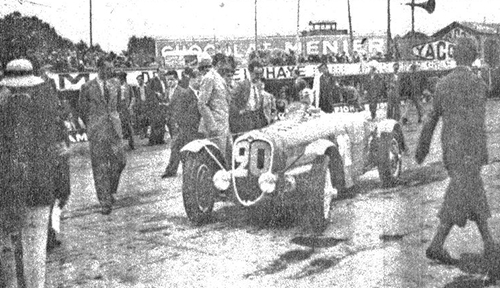
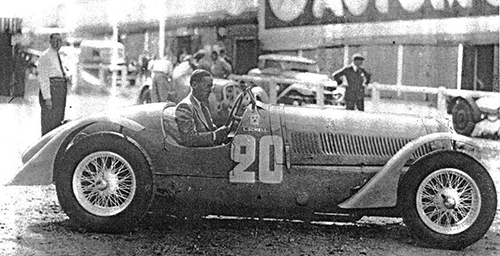
Laury Schell in his 47189 at the 1937 ACF GP.
46835: sold new to the Schells and registered by them as 9266YB5 in the Seine et Oise department in April 1936. In England it was known as Blue Buzz 1, one of the cars of the Schells' team Ecurie Bleue. It competed in some 35 races, had several owners and was rebodied half a dozen times. It is now in the collection of Alexander van der Lof in Holland.
47189: this is the second works car, sold to the Schells and registered by them as 6147YB7 in the Seine et Oise department in February 1937. After the war it was sold to Argentina where it had many owners. It returned to Europe in 1988, had a few more owners, and is now in the collection of Alexandre Oet in Belgium.
46075: sold new to René Le Begue and registered in Paris as 1581RK2 in April 1936. This was a 135 Competition (short chassis). He sold it a couple of years later and it changed hands a few times until 1955 when it disappeared from the racing scene, when its owner left for Saigon in Indochina.
46094: sold new to a close friend of the Schells, Joseph Paul, who registered it in the Seine et Oise department as 4400YB5 in December 1935. It had a very long and successful career competing in over 50 races. After the war, it was sold, had quite a few owners and was rebodied many times. It is now owned by Erich Traber in Switzerland.

